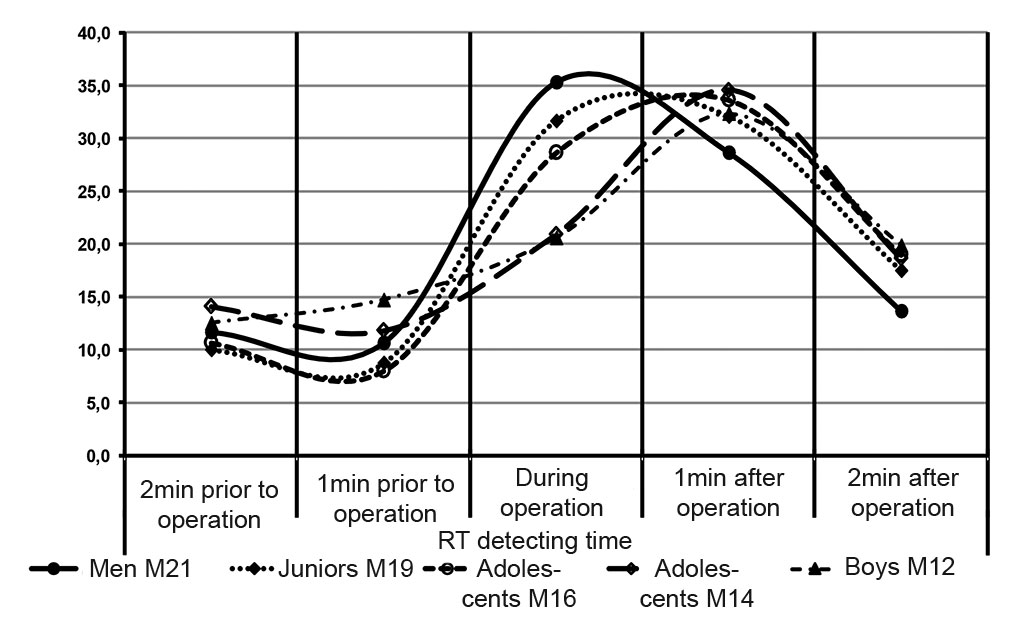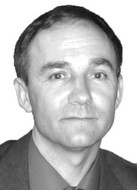Competitive radio location process design at every stage of long-term training system
Фотографии:
ˑ:
PhD K.G. Zelensky
North-Caucasus Federal University, Stavropol
Keywords: competitive radio location, long-term training, radio transmitter location process.
Background. Essentially the modern amateur radio direction finding (ARDF) sport discipline implies competitions in the individual fast direction finding skills using portable radio receivers equipped with directional aerials, with the competitors required to detect low-power radio transmitters in the shortest possible period of time – normally in the broken terrain [1].
Today competitive performance analysis (CPA) is ranked among the top priority tools of the precompetitive training process. For the purposes of such an analysis, the competitive performance frame needs to be designed with its elements and their interconnections [2]. The key objective of a competitive performance analysis is to design and manage a long-term training process. Every component of the modern competitive performance in the ARDF cannot be fully analyzed in a single research and, therefore, our study was focused on the technical parameters of competitive performance (CP) and classical distances at different stages of the long-term training process, with a special priority to the technical and tactical aspects of the competitive performance.
Objective of the study was to explore the competitive performance technicalities at standard distances versus the radio transmitters positioning versions, with the technical and tactical performance aspects.
Methods and structure of the study. For the modern ARDF study purposes we analyzed more than 300 competitive starts in classical disciplines for the period of 2000 through 2017. Subject to analysis were the age-specific competitive events and accomplishments in the 3.5MHz/ 144MHz Amateur Radio Direction Finding disciplines for the 10-19 year-olds varying from beginners to world class athletes. In the senior men’s Group М21, we analyzed the events in the World, European and Russian championships; in the junior male 17-19 year-old Group М19 and adolescent male 13-16 years-old Groups М14 and М16, we analyzed the events in the World, European and Russian Youth championships; and in the 10-12 year-old boys’ Group М12, we analyzed the events in the Russian Cup and Championships for this age group. We have analyzed the age-specific radio direction time and competitive performance at standard distances.
The CPA was designed to rate the competitors’ speed at different distances with ascends versus training-stage-specific distance parameters including routes and numbers of detected radio transmitters.
Analysis of ARDF at standard distances identified the following key distance planning versions: (1) Start and finish are located fairly close to each other (under 1km) within the RDF area, with the version conventionally called Circle-1; (2) Start and finish are close to each other in the RDF area center, with the version conventionally called Circle-2; (3) Start is in the center and finish is far away from it (at least 1.5km afar) on the borderline of the RDF area, with the version conventionally called Envelope-1; (4) Start and finish are located far from each other (at least 1.5km afar) on the borderline of the RDF area, with the version conventionally called Envelope-2; and (5) Start and finish are located far from each other on the opposite sides of the RDF area, with the version conventionally called Envelope-3.
Study results and discussion. The CPA showed that at the beginner stage (Group М12) the athletes detect 2 RT, with the average distance estimated at 2,655±386m and the total ascends making up 50±43m: see Table 1 hereunder.
Table 1. CP variations at standard ARDF distances in the long-term training system ![]() ± σ
± σ
|
Competitive performance factors and rates |
Competitors’ age groups |
|||||
|
М12 (n=28) |
М14 (n=44) |
М16 (n=78) |
М19 (n=74) |
М21 (n=82) |
||
|
Distance, m |
2655 ±386 |
3842 ±788 |
5254 ±924 |
7123 ±1221 |
7629 ±1250 |
|
|
RDF numbers |
2,0 |
3,2±0,4 |
4,5±0,5 |
4,3±0,5 |
5,0 |
|
|
Winners speed, ms −1 |
1,31 ±0,29 |
1,81 ±0,30 |
1,90 ±0,33 |
2,07 ±0,42 |
2,23 ±0,36 |
|
|
Total ascends, m |
50±43 |
79±49 |
122±53 |
188±107 |
221±119 |
|
|
Distance design version |
Circle-1, % |
55 |
26 |
19 |
15 |
9 |
|
Circle-2, % |
0 |
3 |
2 |
0 |
0 |
|
|
Envelope-1, % |
0 |
6 |
4 |
4 |
4 |
|
|
Envelope-2, % |
30 |
38 |
41 |
49 |
49 |
|
|
Envelope-3, % |
15 |
27 |
34 |
32 |
39 |
|
The CPA showed that the radio direction finding, searching and orienteering skills of the junior groups are still imperfect and unskilled and, hence, their speed at distance is low, averaging 1.31±0.29 ms−1 for the boys’ group.
The analysis shows that the route arrangements are quite simple at the beginner training stage, with the start and finish located fairly close to each other (Circle-1 version: 55%) or on the sides of the RDF area (Envelope-1 version: 30%). In these route arrangement versions with less than two RT located, a special priority shall be given to technical skills the radio locator handling, fast search and direction finding skills.
At the primary specialization stage (Group М14), the competitive performance rates drastically grow by 45% on average. Distances in the adolescent Group М14 were estimated at 3,842±788m with the total ascends making up 79±49m. The analysis shows that the junior athletes’ (Group М14) skills grow on the whole with age with the distance increasing by 45%, and effective speed growing by 40% to average 1.81±0.30ms−1. The RT direction finding rate in Group М14 grows as well with the route arrangement tools being expanded to require versatile and fairly high technical and tactical skills.
The CP analysis of the advanced specialization group (Group М16) shows the growing difficulty levels of the distances, with the routes growing up to 5,254±924m on average, effective speed coming to 1.90±0.33ms−1 and ascends amounting to 123±53m. The route arrangements are increasingly difficult and require special technical and tactical knowledge and skills from the athletes.
At the sport excellence pre-elite stage (Group М19), the CP structure is notably transformed, with the route difficulty levels nearing those for adult athletes. Thus, the distances for the junior (Group М19) and men’s (Group М21) groups grow to 7,133±1221m and 7,629±1250m, respectively, with the total altitudes increased to 188±107m and 221±119m, respectively. It is natural that the average effective speed in the men’s group is higher (2.23±0.36ms−1) than in the junior group (2.07±0.42ms−1).
In the amateur radio direction finding (ARDF) process, the competitors are expected to detect the radio transmitters (RP) operating in a cyclic manner, i.e. each RT operates for 1min and stays silent (keeps pause) for 4min. As seen from the analysis, the individual ability to detect an RT prior to, during and after an operation is indicative of the individual technical and tactical skills and physical fitness rate.
To obtain data on the age-specific RT (operating in the 5min cycle) direction finding success and variations, we examined the competitive records of the top ten athletes in the top-ranking events (including the 2016 World Championship and 2015/16 European Championships) in the 3.5MHz/ 144MHz Amateur radio direction finding disciplines for the men’s Group М21 and junior Group М19. In case of the adolescent Groups М14 and М16, we processed the competitive records of the 2017 World Championship and 2015/16 European Championships; and in case of the boys’ Group М12, we processed the competitive records of the 2015-17 Russian Cups.
The reported data analysis found the RT direction finding statistics with the breakdown by pre- on- and post-operational directions (i.e. 2/1min prior to RT operation, during operation and 1/2min after operation). Given on Figure 1 hereunder is the variation analysis showing the domination (53‒64% of the cases) of the RT directions during its operation and 1min after, with the percentage rates of the on- and post-operational directions varying depending on the athlete’s skills, fitness and experience.
At the beginner (Group М12) and primary sport specialization (Group М14) stages, the shares of the RT directions are virtually the same, i.e. 20.6-20.9% and 32.4-34.5% of the directions occur during and 1min after the RT operation, respectively.
Starting from the advanced specialization (Group М16) and sport excellence (Group M19) stages, the RT on-operation direction finding skills grow to 28.7 and 31.7% of the cases, respectively. It should be noted that the RT direction finding rate 1min after the operation at these stages grows to 33.7% and 32.1%, respectively.
In the World and European Championships, the men’s Group М21 (n=80) detected 35.3% during the RT operation time, with the total detected RT reported at n=300; with the RT direction finding rate 1min after the operation estimated at 28.7% of the total.

Figure 1. Radio transmitter (RT) detecting statistics for the 5min operation cycle at standard distances, classified by the competitors’ age groups
Conclusion. At the beginner stage of the long-term training (Group M12), the route arrangements (in versions Circle-1 and Circle-2) are simple enough to require only basic tactical knowledge, technical skills, i.e. the primary radio direction finding skills plus basic physical fitness.
At the primary sport specialization stage (13-14 year-old group), the standard route difficulty rates notably increase (by 45% on average) to require due physical fitness, tactical and technical performance from the junior athletes.
At the further specialization stage (15-16 year-old group), the route difficulty rates further increase in distances, ascends, numbers of RT for detecting and route arrangements.
It was found that the competitive distance design for the junior (Group М19) and adult (Group М21) athletes are largely similar and notably more difficult versus those for the adolescent Group M16 (15-16 year-old). The top-ranking youth and men’s competitions are dominated by the distance design versions Envelope-2 (49%) and Envelope-3 (32-39%) that require, in addition to high physical fitness and functionality rates, excellent technical skills for success of the radio search and direction finding, plus the ability to efficiently and effectively solve a variety of tactical problems. It was further found that the RT detecting skills during operation tend to grow with the age and skills of the athletes from 20.6% in the beginner group to 35.3% in the world class group.
References
- Zelensky K.G. Struktura sorevnovatelnoy deyatelnosti pri prokhozhdenii klassicheskoy distantsii v sportivnoy radiopelengatsii [Structure of competitive activity in classical distance run in amateur radio direction finding]. Uchenye zapiski un-ta im. P.F. Lesgafta, 2014, no. 7 (113), pp. 73– 77.
- Krasnikov A.A. Problemy obschey teorii sportivnykh sorevnovaniy [Problems of general theory of sports competitions]. Moscow: SportAkademPress publ., 2003, 324 p.
Corresponding author: ardf_zelenskii@mail.ru
Abstract
The article considers the amateur radio direction finding process design for every stage of the long-term training system in application to junior (10-19 year-old) and adult (world class) competitors. Objective of the study was to explore the competitive performance technicalities at standard distances versus the radio transmitters detecting versions, with the technical and tactical performance aspects. For the study purposes we analyzed more than 300 competitive starts for the period of 2000 through 2017. We analyzed the 10-12 year-old competitors’ performance at standard distances at World, European and Russian championships. The study data made it possible to find the key competitive performance rates for every stage of the long-term training system in amateur radio direction finding; and offer the key versions of the competitive performance at distances for every stage of the long-term training system. It was found that the radio transmitter (RT) detecting success at distance largely depends on the competitors’ technical and tactical skills and physical fitness, conditional on the radio transmitters operating in a cyclic regime.


